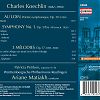cd

JULIAN WALDER - (R)-EVOLUTION
JULIAN WALDER, violin · ELIAS PRAXMARER, organ
Hörprobe
Weitere Bilder

DOMENICO FERRARI
Artem Dzeganovskyi · Leonardo Gatti · Sonia Hrechorowicz
The name of Domenico Ferrari (1722-1780) was well known throughout Europe in the second half of the 18th century. He was considered one of the finest violin virtuosos as well as a sublime composer. One of Tartini’s best Italian pupils, Ferrari quickly gained fame first at the imperial court in Vienna and later at the Württemberg court in Stuttgart. After his successful debut at the Concert Spirituel in Paris in 1754, he was granted a ten-year royal privilege to publish his works in France, where he remained until the end of his life, never to return to his native Piacenza. During his stay in Paris, Ferrari published six sets of sonatas for violin with continuo. His Op. 3, featured on this CD, dates back to 1760 and consists of six sonatas. These works showcase a blend of late Baroque and Classical characteristics.
Hörprobe
Weitere Bilder

DMITRI SHOSTAKOVICH - Jazz Suites
Rundfunk-Sinfonieorchester Berlin · Steven Sloane · MDR Sinfonieorchester · Dmitrij Kitajenko
Dmitri Shostakovich is first and foremost known for his symphonies and string quartets – works that contain some humor, but even more darkness, brooding, and desolation. But there is the jaunty side of the great composer, too, and nowhere does it come to its cheerful fore than in these works, the Jazz Suites, the Tahiti Trot, and his Ballet Suites. This set, accompanying Capriccio’s boxes of Shostakovich’s Symphonies, Film Music, Orchestral Songs, and Chamber Music, is rounded out with two concertos. In the playful Piano Concerto, that humorous side comes through in the many quotations of songs, own works, and Beethoven. Only the grim Violin Concerto, held back, like the 4th Symphony, for fear of retribution, offers no smile.
Hörprobe
Weitere Bilder

Charles Koechlin
Patricia Petibon Württembergische Philharmonie Reutlingen · Ariane Matiakh
It took almost 100 years for Charles Koechlin’s First Symphony to get a proper recording and over a year for Ariane Matiakh to prepare the material. After her highly praised recording of Koechlin’s Seven Stars Symphony (C5449), this is a much-appreciated further foray into the largely unexplored symphonic world of this fascinating composer, a French Chameleon of sorts, who felt comfortable anywhere between Bachian counterpoint and the heights of French impressionism. The earlier Au loin, Poème symphonique and 3 Mélodies (orchestrated posthumously) round out the scintillating picture.
Hörprobe
Weitere Bilder

Miklós Rózsa
HARRIET KRIJGH · NIKITA BORISO-GLEBSKY DEUTSCHE STAATSPHILHARMONIE RHEINLAND-PFALZ · GREGOR BÜHL
This release further explores the rarely performed or recorded concert music of Miklós Rózsa (of Ben Hur fame), coupling his Rhapsody for Cello in which the young composer truly found his style, his Notturno Ungherese (“a nostalgic night piece, harking back to the memories of my childhood in Hungary”), and the late Sinfonia concertante for violin and cello, a fiendishly difficult violin-cello double concerto that is among Rózsa’s finest, least film-music-like concert works – and one of his most underrated. Gregor Piatigorsky and Jascha Heifetz, who instigated its composition, never ended up playing it, but Harriet Krijgh and Nikita Boriso-Glebsky certainly do.







































































































































































































































































































































































































































